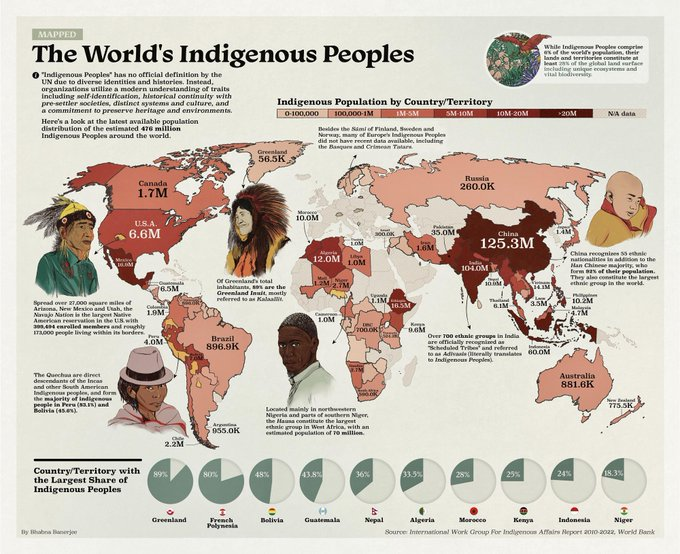Map of the World's Indigenous Peoples


Alex Cartwright
Senior Cartographer & GIS Specialist
Alex Cartwright is a renowned cartographer and geographic information systems specialist with over 15 years of experience in spatial analysis and data...
Geographic Analysis
What This Map Shows
The "Map of the World's Indigenous Peoples" by Bhabna Banerjee, published by Visual Capitalist, offers a comprehensive visualization of the diverse Indigenous populations across the globe. Based on data from the International Work Group for Indigenous Affairs (IWGIA) and the World Bank spanning from 2010 to 2022, this map identifies and highlights the locations where Indigenous peoples reside, emphasizing their unique cultural identities, languages, and traditions. It is more than just a geographical representation; it provides insight into the rich tapestry of human history and the ongoing struggles that these communities face.
Deep Dive into Indigenous Peoples
Indigenous peoples are defined as the original inhabitants of a given region, possessing distinct cultural identities, languages, and ties to their ancestral lands. They often have a profound connection to their environments, practicing traditional ways of life that have been passed down through generations. However, the numbers of Indigenous peoples are dwindling due to factors such as colonization, globalization, and environmental changes. Interestingly, the United Nations estimates there are approximately 476 million Indigenous peoples worldwide, making up about 6.2% of the global population.
One of the most striking features of Indigenous populations is their linguistic diversity. There are over 4,000 distinct Indigenous languages, many of which are at risk of extinction. For instance, in Australia, the number of Aboriginal languages has declined significantly, with only about 120 still spoken today. Similarly, in North America, many Native American languages face similar threats, with efforts underway to revitalize and preserve them.
The map illustrates the concentration of Indigenous peoples in various regions, including the Americas, Asia, Africa, and Oceania. In the Americas, Indigenous groups like the Quechua in Peru and the Navajo in the United States represent vibrant cultures with rich traditions and histories. On the other hand, Indigenous communities in Asia, such as the Ainu in Japan and the Indigenous peoples of the Philippines, face challenges related to land rights and cultural preservation, often battling against encroaching development.
Interestingly, the global recognition of Indigenous rights has gained momentum in recent decades, particularly since the adoption of the United Nations Declaration on the Rights of Indigenous Peoples (UNDRIP) in 2007. This framework aims to protect the rights and cultures of Indigenous peoples, advocating for their right to self-determination and the conservation of their lands. However, implementation varies widely by country, leading to disparities in how Indigenous rights are upheld.
Regional Analysis
When we break down the map regionally, we see significant variations in the distribution and status of Indigenous peoples. In North America, Indigenous groups like the Lakota, Hopi, and Cree not only face social and economic challenges but also actively engage in movements for land rights and cultural revitalization. For example, the Standing Rock Sioux Tribe's fight against the Dakota Access Pipeline in 2016 underscored the intersection of environmental issues and Indigenous rights, drawing international attention.
In contrast, Indigenous peoples in South America, such as the Yanomami in Brazil and Venezuela, face threats from illegal mining and deforestation, which jeopardize their traditional lands and livelihoods. The map highlights the Amazon rainforest, a critical area for Indigenous communities, showcasing the ongoing struggle against exploitation and the fight for environmental justice.
Meanwhile, in Australia, Indigenous Australians, including the Aboriginal and Torres Strait Islander peoples, are increasingly asserting their land rights. The landmark Mabo decision of 1992 recognized native title for the first time, reshaping the legal landscape for Indigenous land ownership. However, social inequalities persist, emphasizing the need for ongoing advocacy.
In Africa, Indigenous groups like the Maasai and San are often marginalized in national policies, facing challenges in preserving their traditional lifestyles amidst economic pressures and climate change. The map reveals their geographic distribution, but it also hints at their ongoing struggles for recognition and rights.
Significance and Impact
Why does this topic matter? The plight of Indigenous peoples is crucial not only for ethical reasons but also for global biodiversity and cultural heritage. Indigenous communities often serve as stewards of the land, utilizing sustainable practices that have been honed over centuries. Their knowledge systems contribute to biodiversity conservation, making their rights and territories vital in combating climate change.
Furthermore, as globalization continues to affect local cultures, the preservation of Indigenous identities becomes increasingly urgent. The map serves as a reminder of the importance of recognizing and respecting these diverse cultures. Current trends indicate a growing awareness and advocacy for Indigenous rights, but challenges remain. Future projections suggest that as climate change accelerates, Indigenous knowledge will be crucial in developing adaptive strategies for environmental resilience.
In conclusion, the "Map of the World's Indigenous Peoples" provides a necessary lens through which to view the complexities and richness of Indigenous cultures. It reminds us of the ongoing journey towards justice and equality for Indigenous communities globally, highlighting their resilience and the cultural wealth they bring to our world.
Visualization Details
- Published
- October 21, 2025
- Views
- 36
Comments
Loading comments...